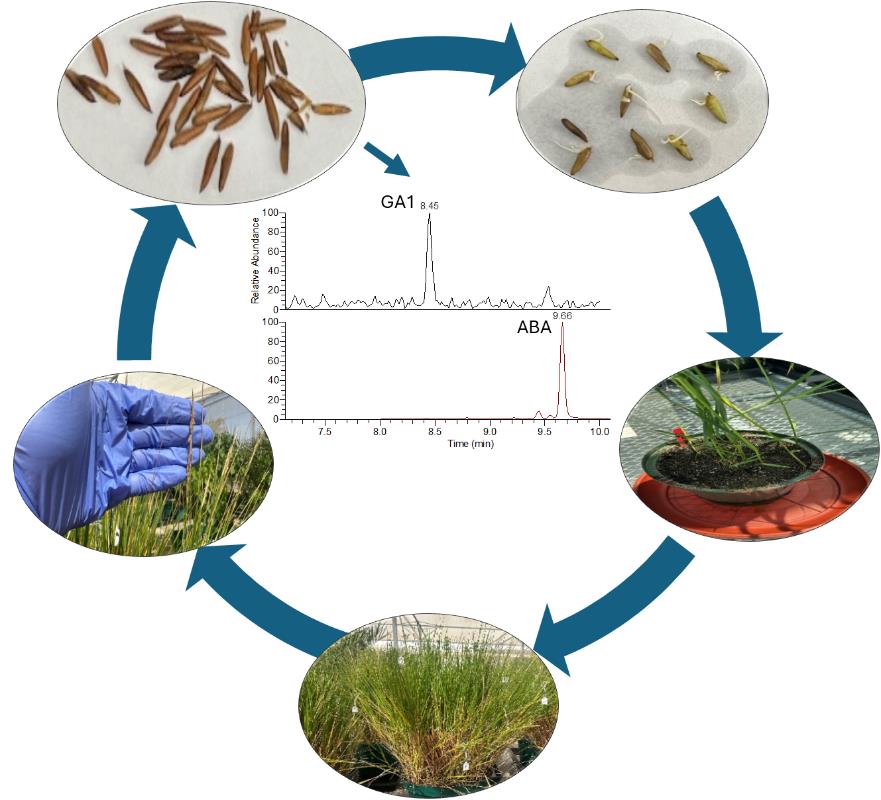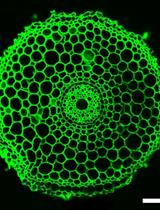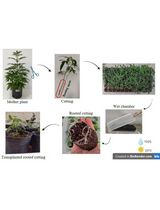- EN - English
- CN - 中文
Development of a Rapid and Efficient Protocol for Seed Germination and Seedling Establishment of Oryza coarctata
一种快速高效的Oryza coarctata种子发芽与幼苗建立方法
发布: 2025年02月20日第15卷第4期 DOI: 10.21769/BioProtoc.5203 浏览次数: 1775
评审: Samik BhattacharyaArsheed Hussain SheikhAnonymous reviewer(s)
Abstract
Seed germination is a critical and challenging process in the propagation of Oryza coarctata, a wild halophytic rice species. This protocol outlines the seed germination procedure for O. coarctata. All steps required for optimal germination and seedling establishment of O. coarctata in both sterile and soil-based systems are described in detail. Additionally, the protocol includes an analysis of the primary hormones, abscisic acid (ABA) and gibberellin (GA), involved in regulating seed dormancy and germination.
Key features
• This protocol provides detailed instructions for germinating Oryza coarctata and improving its germination rate.
• The protocol enables the successful vegetative and reproductive growth of O. coarctata in soil.
• Additionally, the protocol outlines the analysis of hormones (abscisic acid and gibberellin) that play key roles in the germination process.
Keywords: Oryza coarctata (Oryza coarctata)Graphical overview

Protocol for germination, seedling development, and hormone analysis of Oryza coarctata seeds. Step-by-step instructions include germinating seeds on filter papers or sterile growing medium; the established seedlings can be grown in controlled environments or a greenhouse. Extraction and analysis of endogenous key hormones offer insights into their roles in controlling dormancy and germination.
Background
Oryza coarctata is a perennial wild species of rice and the only halophytic species in the genus Oryza (family Poaceae) [1]. It has unique morphological features such as thicker waxy succulent leaves and salt glands, allowing the plant to survive under harsh environmental conditions such as high salinity and submersion [2]. Additionally, O. coarctata leaves have a unique leaf anatomical feature exhibited by C4 plants, the Kranz anatomy (enlarged bundle sheath cells encircling vascular bundles) [3,4]. O. coarctata is primarily found in coastal areas across Southeast Asian countries [1]. O. coarctata offers a wealth of genetic resources for rice breeding research, making it a good model system for investigating mechanisms of salinity and submersion tolerance in rice [5,6]. The germination rate of wild rice seeds is very low, posing significant challenges for research on its conservation. The low germination rate of wild rice seeds leads to inconsistent seedling emergence, causing a reduction in their yield [7]. Dormancy is a limiting factor for the breeding of wild rice, which is regulated by several plant hormones, mainly abscisic acid and gibberellin.
Biotic and abiotic stresses significantly challenge environmental stability and influence the survival of living organisms, including plants. For instance, salinity stress poses significant challenges to global agriculture, affecting production yield, which is essential for human consumption. In addition, salt stress affects around 6% of the world’s cultivable land, making it a significant threat to food security [8,9]. Salt accumulation has various effects, including reduced plant expansion, accelerated wilting, and disrupted photosynthesis. While changing climate intensifies these obstacles, addressing approaches to agriculture, such as genetic engineering to improve crop resilience in response to climatic stresses, is imperative [10,11]. Amongst various climatic stresses, salt concentration remarkably affects rice (Oryza sativa), one of the essential crops. Under these circumstances, the wild rice relative, O. coarctata, has become increasingly significant due to its resistance under salt stress compared to O. sativa. Moreover, cultivation efforts are directed toward producing saline-tolerant crops [12,13]. Therefore, the salt-tolerant characteristics of O. coarctata establish resources for cultivation programs intended to improve the adaptability of rice varieties to high salt levels, thus promoting food stability in regions affected by elevated salinity [4]. Additionally, O. coarctata is a promising candidate for neo-domestication.
Despite its potential as a promising crop for nutritional security, the germination of O. coarctata under experimental and laboratory conditions is challenging. Seed germination is controlled by phytohormones such as gibberellins (GAs) and abscisic acid (ABA) [14]. These hormones are also of particular significance given their role in the regulation of growth and development as well as responses to environmental stresses [15]. For instance, ABA controls plant development from germination to seed dormancy and modulates plant responses to challenging abiotic stresses [16,17]. Apart from their role in inducing seed germination, GAs modulate stem elongation, flower development, fruit ripening, and leaf senescence [18]. The quantitative analysis of these phytohormones is frequently required in both basic plant research and agricultural studies.
Taken together, developing a fast, reproducible, and efficient germination protocol for O. coarctata is crucial for both fundamental research and breeding programs. Establishing this protocol is critical for studying and investigating O. coarctata characteristics, such as biological traits and genetic features, to enhance crop resilience against elevated salt levels in multiple regions worldwide. In this protocol, we outline detailed steps for seed germination and seedling development of O. coarctata. Additionally, we determine the content of key hormones, offering new insights into their roles in controlling dormancy, germination, seedling establishment, and responses to environmental stresses.
Materials and reagents
Biological materials
1. Oryza coarctata seeds; original seeds were obtained from the International Rice Research Institute (IRRI), Philippines. For germination tests, seeds were harvested in our laboratory from plants that were grown at King Abdullah University of Science and Technology (KAUST) greenhouse facility
Reagents
1. Commercial bleach, sodium hypochlorite solution (NaClO) Sigma-Aldrich, CAS number: 7681-52-9)
2. Murashige and Skoog basal medium (MS) (Sigma-Aldrich, catalog number: M5519)
3. Sucrose (Sigma-Aldrich, CAS number: 57-50-1)
4. Agar (Sigma-Aldrich, CAS number: 9002-18-0)
5. LC-grade methanol (VWR, CAS number: 67-56-1)
6. LC-grade water (VWR, CAS number: 7732-18-5)
7. LC-grade acetonitrile (Fisher ChemicalTM, CAS number: 75-05-8)
8. Formic acid (Thermo ScientificTM, CAS number: 64-18-6)
9. Gibberellin A1 (GA1) (Sigma-Aldrich, CAS number: 545-97-1)
10. Abscisic acid (ABA) (Sigma-Aldrich, CAS number: 21293-29-8)
Solutions
1. 1% NaClO (100 mL) (see Recipes)
2. 0.5× MS media (100 mL) (see Recipes)
3. 50% acetonitrile:water (see Recipes)
4. Abscisic acid (ABA) stock solution (1 mg/mL) (see Recipes)
5. Gibberellin A1 (GA1) stock solution (1 mg/mL) (see Recipes)
6. Water containing 0.1% formic acid (1,000 mL) (see Recipes)
7. Acetonitrile containing 0.1% formic acid (1,000 mL) (see Recipes)
Recipes
1. 1% NaClO (100 mL)
| Reagent | Final concentration | Quantity or Volume |
|---|---|---|
| NaClO (5% w/v) | 1% (w/v) | 20 mL |
| Water (ddH2O) | - | 100 mL* |
*Note: Water should be added in increments to reach 100 mL final volume. This solution can be prepared and stored protected from light at room temperature for up to one month.
2. 0.5× MS media (100 mL)
| Reagent | Final concentration | Quantity or Volume |
|---|---|---|
| Sucrose | 2% (w/v) | 2 g |
| MS powder | 0.22% (w/v) | 0.22 g |
| Water (ddH2O) | n/a | 100 mL* |
Adjust pH to 5.8 with 3N HCl or 3N KOH. Add agar to 0.8% and autoclave at 121 °C for 15 min. The medium should be freshly prepared.
*Note: Water should be added in increments to reach 100 mL final volume.
3. 50% acetonitrile:water
| Reagent | Final concentration | Quantity or Volume |
|---|---|---|
| LC-grade water | 50% | 50 mL |
| LC-grade acetonitrile | 50% | 50 mL |
| Total | n/a | 100 mL* |
*Note: This solution can be prepared and stored protected from light at room temperature for up to three months.
4. Abscisic acid (ABA) stock solution (1 mg/mL)
| Reagent | Final concentration | Quantity or Volume |
|---|---|---|
| Abscisic acid | 1 mg/mL | 1 mg |
| LC-grade methanol | - | 1 mL* |
*Note: Working solution (10 µg/mL) from this stock can be prepared and stored protected from light at −20 °C for up to six months.
5. Gibberellin A1 (GA1) stock solution (1 mg/mL)
| Reagent | Final concentration | Quantity or Volume |
|---|---|---|
| Gibberellin A1 | 1 mg/mL | 1 mg |
| LC-grade methanol | - | 1 mL* |
*Note: Working solution (10 µg/mL) from this stock can be prepared and stored protected from light at −20 °C for up to six months.
6. Water containing 0.1% formic acid (1,000 mL)
| Reagent | Final concentration | Quantity or Volume |
|---|---|---|
| Formic acid | 0.1% | 1 mL |
| LC-grade water | 100% | Up to 1,000 mL* |
*Note: Water should be added in increments to reach 1000 mL final volume. This solution should be freshly prepared before analysis.
7. Acetonitrile containing 0.1% formic acid (1,000 mL)
| Reagent | Final concentration | Quantity or Volume |
|---|---|---|
| Formic acid | 0.1% | 1 mL |
| LC-grade acetonitrile | 100% | Up to 1,000 mL* |
*Note: Acetonitrile should be added in increments to reach 1,000 mL final solution.
This solution should be freshly prepared before analysis.
Laboratory supplies
1. Sterile deionized water, room temperature
2. 50 mL tubes (FalconTM, catalog number: 14-432-22)
3. Filter paper (Whatman®, Grade 1, model number: WHA1001090)
4. Parafilm (Fisher Scientific, catalog number: S37440)
5. Laminar flow hood (AIREGARD ES Horizontal Laminar Flow, model number: NU-201/E)
6. Petri dishes (FisherbrandTM, catalog number: AS4052)
7. Tissue culture boxes (e.g., Magenta Vessel with cover) (Sigma-Aldrich, model number: C0542)
8. 5″ diameter round black pots (with holes at the base for drainage)
9. Mixture of soil (Stender) and local sand (3:1)
10. 0.2 µm filter (Target2TM PTFE Syringe Filters, Thermo Scientific™, catalog number: F2504-4)
11. Steel beads (3.2 mm chrome-steel beads, BioSpec Products, Inc., catalog number: 11079132c)
12. 2 mL safe-lock microcentrifuge tubes (Eppendorf, catalog number: 0030123620)
13. 1.5 mL safe-lock microcentrifuge tubes (Eppendorf, catalog number: 0030123611)
14. Autosampler vials (LC screw-thread vials with caps and inserts, VWR®, catalog number: 82030-974A)
15. HPLC column (Hypersil GOLD C18 Selectivity, 150 × 4.6 mm; 3 µm; Thermo ScientificTM, catalog number: 25003-154630)
Equipment
1. pH meter (FisherbrandTM accumetTM AB150 pH benchtop meter, catalog number: 13-636-AB150)
2. 30 °C incubator (FisherbrandTM IsotempTM Incubator, catalog number: 15-103-0515)
3. Culture room/growth chamber (e.g., Conviron, BioChambers, or Percival) [with controlled LED light and humidity controller with humidity range from 60% to 90% relative humidity (RH) and temperature range from 10 °C to 40 °C]
4. Weighing balance (Sartorius M-Power Analytical Balance, model number: AZ214)
5. Tissue grinder (Mixer Mill, RETSCH®, model number: 20.746.0001)
6. Vortexer (VWR® Fixed Speed Vortex Mixer, catalog number: 10153-834)
7. Sonicator (Bransonic® Ultrasonic Cleaner, model: 5510)
8. Centrifuge (EppendorfTM 5424R Microcentrifuge, catalog number: 05-401-205)
9. Vacuum centrifugal concentrator (Eppendorf® Concentrator Plus, catalog number: 5305000568)
10. Liquid chromatography system (Thermo Scientific, model: VanquishTM Duo UHPLC System)
11. Mass spectrometer system (Thermo Scientific, model: TSQ AltisTM triple quadrupole)
Software and datasets
1. Statistical software for data analysis software (Microsoft Excel, Microsoft Corporation, v. 2410, 2024)
2. LC–MS/MS software (Xcalibur 4.1, Thermo Fisher Scientific Inc., USA)
Procedure
文章信息
稿件历史记录
提交日期: Oct 15, 2024
接收日期: Dec 23, 2024
在线发布日期: Jan 9, 2025
出版日期: Feb 20, 2025
版权信息
© 2025 The Author(s); This is an open access article under the CC BY-NC license (https://creativecommons.org/licenses/by-nc/4.0/).
如何引用
Berqdar, L., Salem, M. A., Wang, J. Y., Alrudayan, A., Jamil, M. and Al-Babili, S. (2025). Development of a Rapid and Efficient Protocol for Seed Germination and Seedling Establishment of Oryza coarctata. Bio-protocol 15(4): e5203. DOI: 10.21769/BioProtoc.5203.
分类
植物科学 > 植物育种 > 栽培技术
您对这篇实验方法有问题吗?
在此处发布您的问题,我们将邀请本文作者来回答。同时,我们会将您的问题发布到Bio-protocol Exchange,以便寻求社区成员的帮助。
Share
Bluesky
X
Copy link












